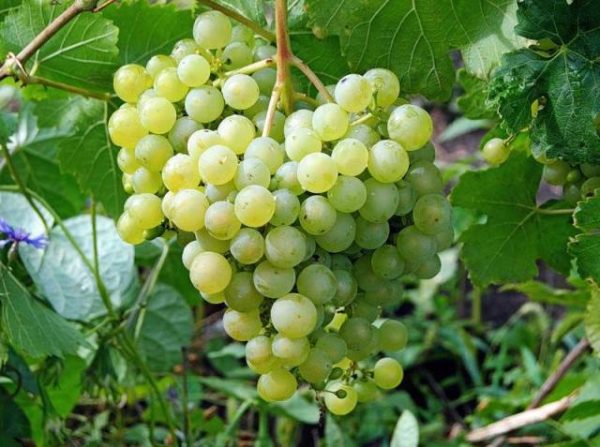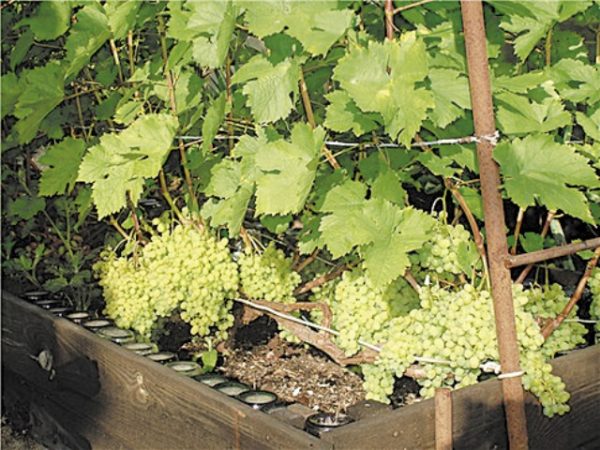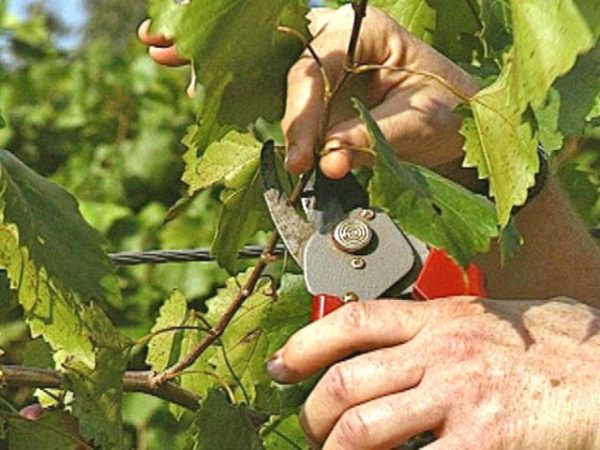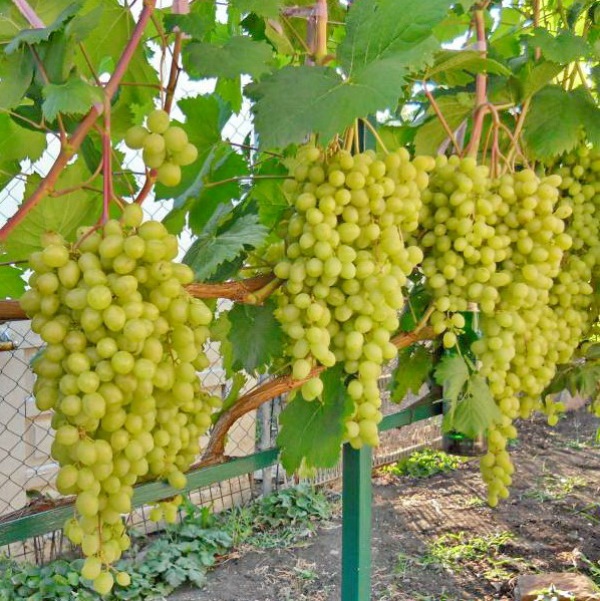What does any gardener and a big farmer want? A good harvest with a minimum expenditure of time and effort - the trend "lazy summer resident." And the breeders are working in this direction - the ease of growing crops, unpretentiousness and, at the same time, abundance and quality of the crop. Such a crop is the Aleshenkin grape variety - even a beginner can cope with the cultivation and enjoy the excellent taste of ripe berries.
Table of contents
The history of grape breeding aleshenkin
The Aleshenkin grape (“Alesha”, “N 328”) in 1956 brought out and described all the characteristics of a variety of Soviet scientist-breeder P.Ye. Tsehmistrenko. And now, for more than half a century, the variety enjoys unchanged popularity, and its distribution area has expanded from the southern regions to the middle belt and even the Moscow region. The scientist crossed the Madeleine Angèveen table variety and a mixture of pollen from Vostok grapes. For excellent taste and appearance, “Alesha” is table grapes and can serve as a model of grape selection.

Description of the variety and berries, their features
Now let's talk about the description. The work of the scientist was aimed at creating a high-yielding hybrid with a bright sweet taste. Hence, all the main characteristics of the variety Aleshenkin:
- Grape bushes vigorous, powerful, sleeves bear fruit for 5-6 years. “Alesha” is distinguished from other varieties by the color and size of the leaves: medium-sized, medium dissected, five-fingered bright emerald colors, which are often characterized as phthalocyanine. The flowers are bisexual, two inflorescences develop on the shoot.
- Maturation term. Grapes are very early varieties.The ripening of the berries occurs 110-118 days after the appearance of the ovaries. The average active temperature index is rather low - 2000.aboutC. Crop usually begin to harvest from late July to late August.
- Aleshenka's productivity is very high - up to 25 kg of selected grapes are harvested from one bush per season. Fruit buds are laid every year, which gives a guarantee of stable yields - of course, with the obligatory observance of the traditional rules of crop care.
- The clusters are very large, branched, slightly friable, cone-shaped. The weight of medium specimens is 500-700 gbut giants weighing 2 kg are not uncommon.
- The berries deserve special attention: a fairly large size - 25-30mm, weight - up to 5g, slightly oval in shape, of a magnificent amber shade with a light, slightly noticeable patina. In each brush, at least 30-35% of the berries are seedless, and the rest contain 1-2 small bones.
- The pulp of the berries is very juicy, crisp and super sweet - sugar content reaches 20% with an acidity of only 5-7 g / l. The taste is very pleasant and memorable - not for nothing, on the tasting scale, connoisseurs rated it at 8.8 points.
The main positive qualities and disadvantages
Let us summarize and see what advantages the Aleshenkin grape has, What are the best qualities he inherited from his parent couple:
- high yields, the ability to get very abundant, early harvests;
- amazing taste, great crunchy texture of the pulp;
- small content of seeds in the berries;
- the excellent ability of the cuttings to root, and the shoots to active ripening, thanks to which it is possible to cultivate the variety practically throughout the entire territory of Russia, with the exception of the northern regions;
- harvest ripening even under unfavorable weather conditions.

Unfortunately, in this “barrel of honey” there is also its own “fly in the ointment”:
- low frost resistance underground parts of plants; that is why it is recommended to graft cuttings to the rootstocks of frost-resistant grape varieties and cover the plants for the winter;
- brushes prone to pea - to avoid this, it is recommended to process the growth stimulator or carry out additional pollination of the inflorescences manually;
- not high resistance to fungal infections.
Landing rules
The variety Aleshenkin, being considered an unpretentious culture, still has its preferences. In order for many years to receive generous yields of tasty, sweet berries, you must follow the rules of planting and growing grapes.
This variety grows very well under film covers without additional heating. Plant best seedlings or rooted cuttings. Place you need to choose an open, sunny, bushes to have at a distance of 1 m from each other. Planting should be done in spring so that the sapling can take root well before the onset of cold weather and avoid freezing of a young plant. It is necessary to carry them into the ground together with the ground in which it began to develop, into a prepared hole 80 cm deep and 70 cm in diameter.
5 cm of crushed stone are poured to the bottom of the pit, then 20 cm of the mixture (earth, humus, sand in equal quantities, 50 g of superphosphate and nitrophoska, a little wood ash), 10-15 cm of humus again, well watered with hot water for shrinkage. Then the pit is filled with earth at 1/3, in the center they drive in a peg to which the seedling is attached.The hole is covered with earth, slightly compacted and watered abundantly for the first 2-3 days, then reduced to moderate watering. The soil around is mulched with peat.

Care for mature vines and young seedlings
The main care is pruning the vine, feeding the bushes and rationing the crop. Pruning is done in early spring (in April), before the buds begin to swell. Remove damaged and diseased branches of plants, weak shoots. The vine is cut into 8-10 holes or 6 holes. Since the variety is high-yielding, in order to avoid overloading the vines, it is rationed, removing unnecessary and double shoots.
Diseases and pests
Unfortunately, this hybrid is not resistant to typical pests and diseases: spider mite, marble crust, leafworm, fungal diseases, mildew, oidium. Therefore, twice a year, it is necessary to spray the grapes with the appropriate preparations - Topaz, Ridomil Gold, Fufaron, and Stroviy. The treatment is carried out in early June and is repeated in early July. For prevention, you can treat the vine at the end of October in preparing the bushes for the winter.

Hybrid Aleshenkin is considered one of the undemanding artificially bred varieties. With simple care, even in not the most favorable conditions, he will delight with exquisite taste, rich harvest.
